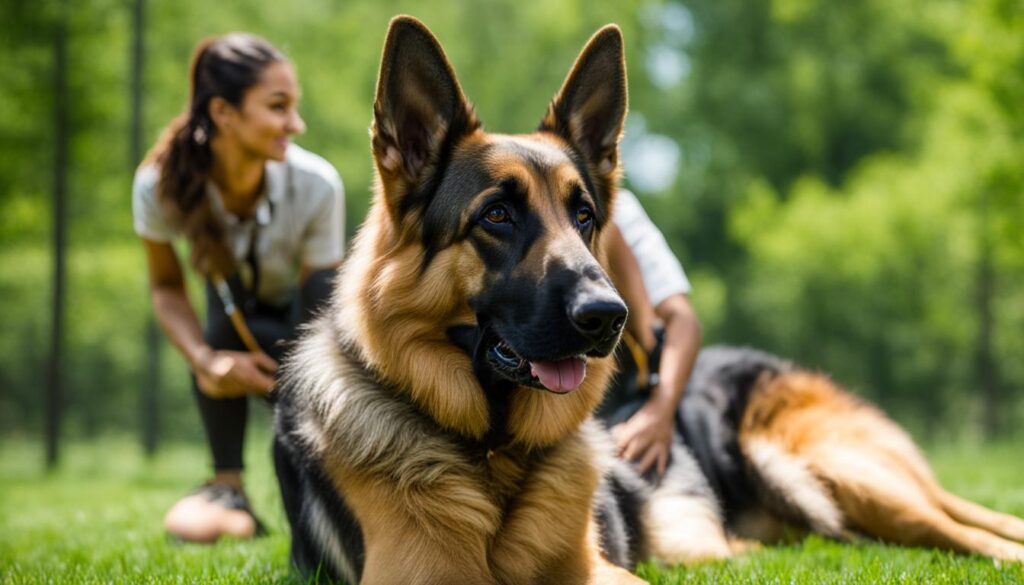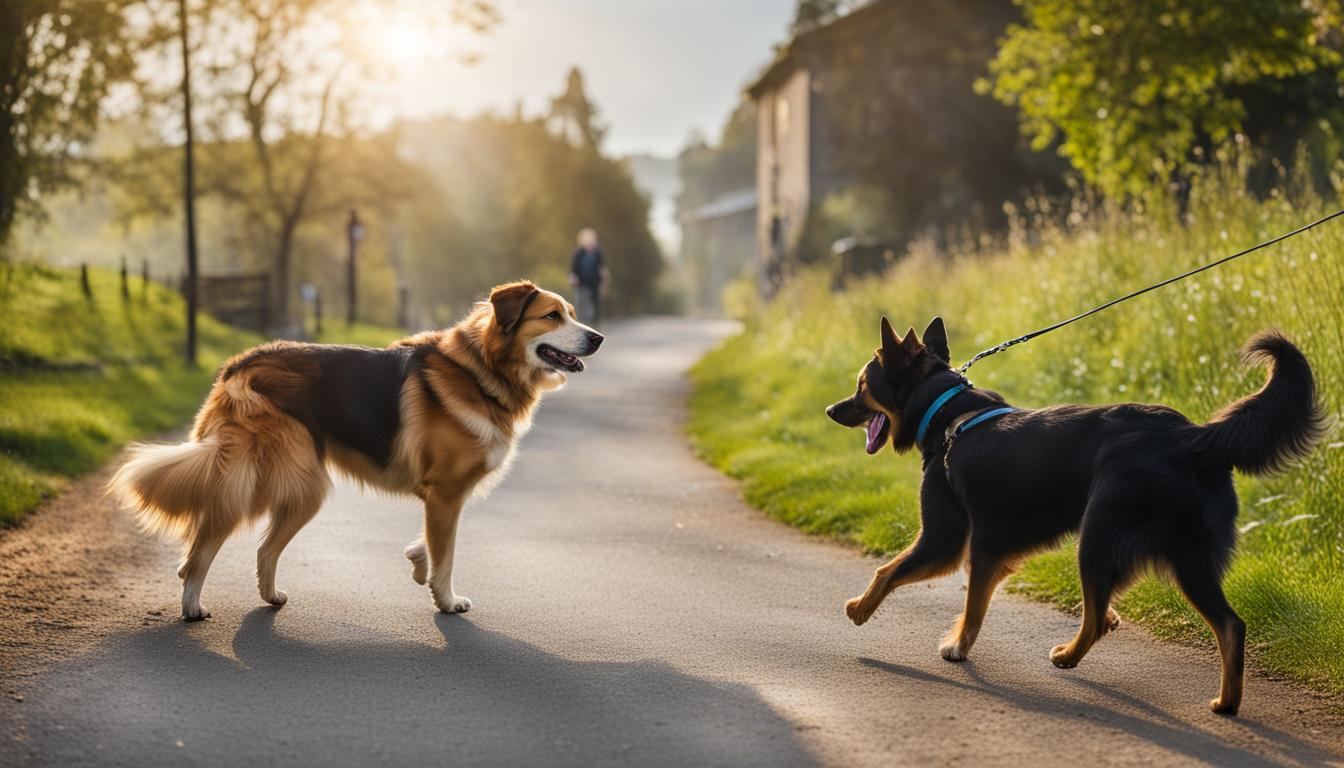Recent research conducted at Nihon University in Japan has shed light on the effectiveness of visual cues, specifically hand signals, in dog training. The study found that dogs responded more promptly and enthusiastically to visual cues compared to auditory cues. This research underscores the significance of incorporating hand signals into dog training practices for improved communication and better outcomes.
Key Takeaways:
- Hand signals are more effective than verbal cues in communicating with dogs during training.
- Incorporating hand signals enhances the bond and understanding between trainers and dogs.
- Training dogs with hand signals improves obedience and behavior.
- Non-verbal communication through hand signals is crucial for deaf dogs.
- Consistency and patience are key when training dogs with hand signals.
The Importance of Visual Cues for Dogs
Dogs are highly responsive to visual cues due to their keen sense of sight. Visual cues, particularly hand signals, provide a clear and consistent way to communicate with dogs during training sessions. Training dogs to recognize and respond to hand signals can be accomplished through lure-and-reward training methods. By using food as a lure and guiding the dog into desired positions using hand signals, dogs can quickly learn to associate specific hand gestures with specific behaviors. Incorporating hand signals in dog training enhances the dog’s understanding and enables effective communication between the trainer and the dog.
The use of hand signals for obedience training offers several advantages. Firstly, it provides dogs with a visual representation of the desired behavior, making it easier for them to understand what is expected of them. Since dogs rely primarily on body language to communicate, using hand signals aligns with their natural communication instincts. Additionally, hand signals are a universal language that can bridge the communication gap between dogs and trainers who may not speak the same verbal language. This makes hand signals particularly useful in multi-lingual or multi-cultural training environments.
“Incorporating hand signals in dog training enhances the dog’s understanding and enables effective communication between the trainer and the dog.”
Integrating hand signals into dog training also promotes consistency in command delivery. Verbal commands can vary in tone or pronunciation, leading to confusion for dogs. However, hand signals have a standardized visual representation, ensuring that the command remains consistent regardless of who is delivering it. This consistency helps reinforce the training cues and reduces the chances of misunderstandings or miscommunications between the trainer and the dog. In turn, this leads to more efficient and effective training sessions, resulting in improved obedience and behavior.
Benefits of Hand Signals in Dog Training
Using hand signals in dog training offers various benefits for both the trainer and the dog. By incorporating visual cues, trainers can foster a stronger bond with their dogs, as the use of hand signals promotes clear and effective communication. This strengthened connection between trainer and dog can enhance the overall training experience and make it more enjoyable for both parties.
Hand signal training is particularly beneficial for dogs with hearing impairments. Deaf dogs rely on visual cues to understand commands and behaviors. By utilizing hand signals, trainers can provide a means of communication that transcends auditory limitations, enabling deaf dogs to actively participate in training sessions and learn desired behaviors.
In addition to improved communication, hand signal training also aids in addressing behavioral issues. The use of clear visual cues can help redirect or correct unwanted behaviors by providing a consistent and easily understandable signal for the dog. This allows trainers to effectively communicate their expectations and guide the dog toward more desirable actions.

| Benefits of Hand Signal Training | Hand Signal Training for Behavioral Issues |
|---|---|
| Promotes clear and effective communication between trainer and dog | Facilitates redirection and correction of unwanted behaviors |
| Strengthens the bond between trainer and dog | Provides a consistent and easily understandable signal |
| Enhances the overall training experience | Aids in the effective communication of expectations |
Understanding Body Language in Dog Training
In addition to hand signals, an understanding of body language is crucial in dog training. Dogs are highly attuned to the body language of humans and use it as a means of communication. Trainers should be mindful of their own body language when giving commands to dogs, as it can influence the dog’s response. By being aware of your posture, facial expressions, and hand movements, you can convey clear messages to your furry friend.
Dogs with hearing impairments can benefit greatly from hand signal training, as it provides them with a visual means of communication. By teaching deaf dogs specific hand gestures to associate with commands, they can understand and respond to cues just like their hearing counterparts. This opens up a world of training possibilities for deaf dogs, allowing them to participate fully in obedience exercises and behavioral training.
Teaching Multiple Hand Signals to Dogs
Another advantage of incorporating hand signals into dog training is the ability to teach multiple commands through different gestures. Dogs are incredibly intelligent creatures, capable of learning and understanding a wide range of hand signals. By assigning unique hand signals to various commands, you can expand your dog’s repertoire and give them a more diverse set of skills.
“Training dogs with multiple hand signals not only challenges their cognitive abilities, but it also strengthens the bond between us. It’s like learning a secret language that only we understand.”
With practice and consistency, you can teach your dog to differentiate between different hand signals and respond accordingly. This can be particularly useful in situations where verbal commands may not be practical or when you want to communicate silently in public spaces. Teaching multiple hand signals is a fun and rewarding endeavor that enriches both your dog’s training experience and your relationship with them.
| Command | Hand Signal |
|---|---|
| Sit | |
| Stay |  |
| Lie Down | |
| Come |  |
The Benefits of Hand Signal Training
Hand signal training offers numerous benefits for both dogs and their owners. By incorporating visual cues into training sessions, the bond and communication between the dog and trainer are enhanced. Dogs are naturally responsive to visual cues, and hand signals provide a clear and consistent way to communicate during training exercises.
One of the key benefits of hand signal training is its effectiveness in addressing behavioral issues. Hand signals provide a direct and non-verbal way to redirect or correct unwanted behaviors. This clear and consistent form of communication helps dogs understand what is expected of them, leading to better obedience and improved behavior.
Furthermore, dogs trained with hand signals tend to be more attentive and responsive overall. Visual cues are a natural way for dogs to understand and respond, and incorporating hand signals into training sessions can greatly enhance the dog’s ability to learn and follow commands. The use of positive reinforcement, such as treats or praise, when the dog correctly responds to a hand signal further reinforces the desired behavior.
The Benefits of Hand Signal Training:
- Enhances communication and strengthens the bond between the dog and trainer
- Provides a clear and consistent way to address behavioral issues
- Improves the dog’s attentiveness and responsiveness during training
- Enables the use of positive reinforcement to reinforce desired behaviors
Overall, hand signal training is a valuable technique that offers a research-backed approach to dog training. Its benefits extend beyond basic obedience, providing an effective tool for addressing behavioral issues and enhancing the overall training experience. So, unleash the power of hand signals and watch your dog respond with enthusiasm and understanding.
Tips for Effective Hand Signal Training
Training dogs with visual cues, such as hand signals, can be a highly effective way to communicate and achieve desired behaviors. To ensure successful hand signal training, follow these tips:
- Use consistent and clear gestures: When teaching hand signals, it’s crucial to use consistent and clear gestures for each command. This helps the dog understand and associate the hand signal with the desired behavior.
- Start with verbal cues: Begin by teaching the hand signal alongside the verbal cue. This combination helps the dog make the connection between the hand gesture and the command. Gradually phase out the verbal cue as the dog becomes more familiar with the hand signal.
- Practice in different environments: To generalize the hand signals, practice them in various environments. Start with a familiar setting, then gradually introduce distractions. This helps the dog learn to respond reliably to the hand signals in different situations.
- Use positive reinforcement: When the dog correctly responds to a hand signal, reinforce the behavior with positive reinforcement. This can be treats, praise, or any other reward that motivates the dog. Positive reinforcement strengthens the association between the hand signal and the desired behavior.
Remember, consistency and patience are key when training dogs with hand signals. It may take time for the dog to fully understand and respond to the signals, so be patient and continue reinforcing the training. With practice and positive reinforcement, hand signal training can greatly enhance communication and obedience with your dog.

Sample Hand Signal Training Exercise:
Here’s a sample exercise to get started with hand signal training:
- Select a simple command, such as “sit.”
- Hold a treat in your hand to get the dog’s attention.
- With your other hand, make a clear and consistent gesture for the “sit” command, such as raising your hand with an open palm.
- Say the verbal cue “sit” while simultaneously showing the hand signal.
- Guide the dog into a sitting position using the treat as a lure.
- Once the dog is in the sitting position, give the treat as a reward.
- Repeat this exercise multiple times, gradually phasing out the use of the treat and relying solely on the hand signal.
By following these tips and practicing regular training sessions, you can effectively train your dog using hand signals and improve their overall behavior and obedience.
Hand Signals in Training Deaf Dogs: Unlocking Communication and Confidence
Training a deaf dog requires a unique approach, and hand signals play a crucial role in bridging the communication gap. By using visual cues, trainers can effectively communicate with deaf dogs and teach them desired behaviors and commands. Hand signal training not only enhances obedience but also promotes a deeper bond and increased confidence in these special dogs.
Benefits of Hand Signal Training for Deaf Dogs
The benefits of hand signal training for deaf dogs are significant. Firstly, visual cues provide a clear and consistent means of communication that transcends auditory limitations. Deaf dogs rely on their keen sense of sight to understand and participate in training sessions. By using hand signals, trainers can establish a strong communication channel with their deaf dogs, leading to better cooperation and understanding.
“Hand signals allow deaf dogs to fully engage in training sessions and build their confidence. They learn to respond to visual cues, making them more independent and capable of following commands without relying on sound.”
Hand signal training also empowers deaf dogs by enhancing their independence. They learn to rely on visual cues, allowing them to follow commands and navigate the world around them with confidence. This builds their self-assurance and overall well-being, ensuring they can lead fulfilling lives as valued members of the family.
Table: Comparing Verbal and Hand Signal Training for Deaf Dogs
| Training Aspect | Verbal Training | Hand Signal Training |
|---|---|---|
| Communication | Dependent on sound | Visual and independent |
| Accuracy | May be compromised due to hearing limitations | Highly accurate, as visual cues are easily understood |
| Confidence | Potential dependence on sound may lower confidence | Builds confidence and independence in deaf dogs |
| Bonding | Dependent on sound-based commands | Strengthens bond through visual communication |
“Hand signal training empowers deaf dogs by providing a visual means of communication, enabling them to thrive in their training and daily lives. It is a valuable tool that ensures deaf dogs receive the same level of understanding and care as their hearing counterparts.”
In conclusion, hand signal training plays an integral role in training deaf dogs, allowing for effective communication, enhanced obedience, and increased confidence. By understanding and utilizing visual cues, trainers can unlock the full potential of deaf dogs, helping them thrive and be valued companions. Through hand signals, we can bridge the communication gap and foster a stronger bond with our beloved furry friends.
Conclusion
In conclusion, hand signal training is a proven and effective method for enhancing communication and obedience in dogs. The research conducted at Nihon University in Japan clearly demonstrates that dogs respond more quickly and enthusiastically to visual cues, such as hand signals, compared to auditory cues. By incorporating hand signals into your dog training practices, you can establish a clear and consistent means of communication with your furry friend.
Not only do hand signals provide a natural way for dogs to understand and respond, but they also offer numerous benefits for both dogs and their owners. Dogs trained with hand signals are often more attentive and responsive, leading to better obedience and overall behavior. Additionally, hand signals can be particularly beneficial in addressing behavioral issues, as they provide a clear and consistent way to redirect or correct unwanted behaviors.
When implementing hand signal training, it’s important to use consistent and clear gestures for each command. Start by teaching the hand signal alongside the verbal cue, gradually phasing out the verbal cue as your dog becomes familiar with the hand signal. Remember to practice the hand signals in various environments and gradually increase distractions to ensure your dog can respond reliably in different situations. And always be patient and consistent, using positive reinforcement to reinforce the desired behavior.
In conclusion, hand signal training is a powerful tool that can enhance your bond with your dog and improve training outcomes. Whether you’re working on basic obedience commands or training a deaf dog, incorporating hand signals into your training sessions can lead to a more effective and efficient training experience. So why not harness the power of hand signals and train smarter, not harder?
FAQ
How effective are hand signals in dog training?
Recent research conducted at Nihon University in Japan found that dogs respond more quickly and enthusiastically to visual cues, such as hand signals, compared to auditory cues. Hand signals provide a clear and consistent way to communicate with dogs during training sessions, leading to enhanced understanding and better results.
Can hand signals be used with deaf dogs?
Yes, hand signals are particularly beneficial for deaf dogs as they provide a visual means of communication. Deaf dogs rely heavily on visual cues and can successfully learn to respond to hand signals for various commands. Hand signals enable effective communication and foster training participation for deaf dogs.
How can hand signals improve communication and obedience in dogs?
Incorporating hand signals into dog training enhances the bond and communication between the dog and trainer. Dogs trained with hand signals are often more attentive and responsive, leading to better obedience and overall behavior. Hand signals provide a clear and consistent way to redirect or correct unwanted behaviors, resulting in improved training outcomes.
How should I introduce hand signals during training sessions?
Start by teaching the hand signal alongside the verbal cue, and gradually phase out the verbal cue as the dog becomes familiar with the hand signal. Practice the hand signals in various environments and gradually increase distractions to ensure the dog can respond reliably in different situations. Using positive reinforcement, such as treats or praise, when the dog correctly responds to a hand signal will reinforce the desired behavior.
Can dogs learn multiple hand signals for different commands?
Absolutely! Dogs can learn and understand multiple hand signals for different commands. Teaching dogs a variety of hand signals expands their repertoire of commands and increases their ability to understand and respond to different cues. Consistency and patience are key when training dogs with hand signals.
What are the benefits of hand signal training?
Hand signal training enhances the bond between dogs and their trainers, improves communication, and promotes better obedience. It provides a clear and consistent means of communication that dogs naturally understand and respond to. Additionally, hand signals can be beneficial in addressing behavioral issues as they provide a clear and immediate way to redirect or correct unwanted behaviors.
Are hand signals more effective than verbal cues alone?
Recent research has shown that hand signals are more effective than verbal cues alone in communicating with dogs. Dogs are highly responsive to visual cues due to their keen sense of sight, making hand signals an important tool in training and obedience exercises. Incorporating hand signals into training sessions can lead to more effective and efficient training outcomes.
How should I use body language in dog training?
Dogs are highly attuned to the body language of humans and use it as a means of communication. Trainers should be mindful of their own body language when giving commands to dogs, as it can influence the dog’s response. By being aware of your body language and using consistent hand signals, you can effectively communicate your expectations to your dog during training sessions.





